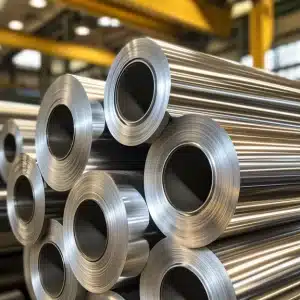
What Manufacturers Need to Know About Hazardous Material Compliance
In U.S. manufacturing, pressure vessels play a crucial role in storing and processing hazardous materials—gases, liquids, and chemicals that, if mishandled, can pose serious threats to worker safety, public health, and the environment. Ensuring Hazardous Material Compliance isn’t just a best practice—it’s a regulatory necessity.
With oversight from OSHA, the EPA, and the DOT, manufacturers must adopt comprehensive safety protocols, rigorous inspection routines, and proper documentation practices. This guide explains what Hazardous Material Compliance means for pressure vessels and how your facility can align with the latest safety and environmental regulations.
What Is Hazardous Material Compliance in Manufacturing?
Defining Hazardous Materials and Pressure Vessel Use
Hazardous materials—also known as HAZMAT—are any substances that could cause harm to humans, animals, or the environment due to their chemical, biological, or physical properties. These include flammable gases, corrosive liquids, toxic chemicals, and reactive compounds.
Pressure vessels are specially engineered containers used to hold these hazardous materials under high pressure or temperature. Industries that commonly use pressure vessels include:
- Chemical manufacturing
- Oil and gas processing
- Pharmaceutical production
- Food and beverage manufacturing
- Pulp and paper
Due to the risks involved in storing or processing HAZMAT in these containers, strict Hazardous Material Compliance protocols are in place to minimize exposure, prevent leaks, and ensure safe handling.
Regulatory Bodies and Standards
Three main U.S. agencies govern Hazardous Material Compliance:
- OSHA (Occupational Safety and Health Administration): Focuses on worker safety and mandates handling, labeling, and PPE standards.
- EPA (Environmental Protection Agency): Regulates environmental emissions, spill containment, and chemical usage.
- DOT (Department of Transportation): Ensures safe transport of hazardous materials by road, rail, air, and water.
Key regulations manufacturers must follow include:
- HAZMAT regulations (49 CFR): Covers the classification, labeling, and transport of hazardous materials.
- HAZWOPER (29 CFR 1910.120): OSHA’s standard for hazardous waste operations and emergency response.
- The Clean Air Act: Limits emissions and requires permits for air pollutants.
- ASME Boiler and Pressure Vessel Code (BPVC): Sets the technical design and testing standards for pressure vessels.
Together, these agencies and codes form the foundation of Hazardous Material Compliance for pressure vessel operations.
Key Compliance Requirements for Pressure Vessels
Material Storage and Labeling Protocols
Proper labeling and storage are at the core of Hazardous Material Compliance. OSHA and DOT regulations require clear identification of all chemicals, including:
- GHS-compliant labels with pictograms and hazard warnings
- Segregation of incompatible substances to avoid chemical reactions
- Secondary containment for spill control
- Inventory tracking and chemical logbooks
All pressure vessels must be located in designated HAZMAT storage areas, with access controls and visible hazard signage. Non-compliance with labeling or storage can lead to fines or, worse, dangerous accidents.
Inspection, Testing, and Documentation
To maintain Hazardous Material Compliance, pressure vessels must be routinely tested and certified per ASME Section VIII standards and local authority guidelines.
Requirements include:
- Initial hydrostatic or pneumatic testing to confirm vessel integrity
- Regular internal and external inspections (often every 1–5 years)
- Ultrasonic or radiographic testing for wall thinning or corrosion
- Leak detection systems and pressure relief valve testing
Documentation is equally important.
Manufacturers must maintain:
- Material Safety Data Sheets (MSDS)
- Inspection logs and repair records
- Operator training documentation
- Permits and emissions reports
Proper documentation is not only a regulatory requirement—it’s a best defense in audits or legal situations.
Safety Protocols and Risk Mitigation
Emergency Response and Spill Containment
Even the most compliant systems can encounter emergencies. A key part of Hazardous Material Compliance is preparing for incidents through proactive planning and training.
Best practices include:
- Spill kits near every HAZMAT storage or transfer area
- Clearly documented emergency response plans aligned with OSHA and EPA rules
- Training drills for scenarios such as leaks, ruptures, or chemical exposure
- Integration with broader facility emergency protocols, including evacuation procedures
Immediate, informed action during a spill can prevent environmental damage and protect employee health.
Employee Training and PPE Standards
People are at the heart of any compliance effort. OSHA mandates specific training programs for employees who handle or work near hazardous materials.
Training should include:
- Initial HAZMAT training and job-specific modules
- Annual refresher courses
- Emergency response instruction per HAZWOPER
Employees must also have access to and training in using appropriate Personal Protective Equipment (PPE), such as:
- Chemical-resistant gloves
- Full-face respirators or masks
- Protective suits
- Eye and face shields
Ensuring that all team members are confident and capable in HAZMAT scenarios is a cornerstone of Hazardous Material Compliance.
Avoiding Common Compliance Pitfalls
Outdated Certification or Missing Documentation
One of the most frequent violations of Hazardous Material Compliance is the use of uncertified or outdated pressure vessels. Even small lapses in inspection schedules or documentation can lead to non-compliance.
To stay ahead:
- Implement automated compliance reminders
- Use centralized digital logbooks for easy access
- Work with certified inspectors and third-party auditors
Being audit-ready at all times is essential.
Inconsistent Training or Equipment Failures
Another critical risk is employee turnover or aging equipment. If new staff are not properly trained—or if maintenance is skipped—compliance and safety can both falter.
Strategies to stay on track include:
- Routine safety audits
- Scheduled preventive maintenance for valves, gauges, and sensors
- Cross-training employees in HAZMAT roles
- Reporting systems for near-miss incidents
Proactive action prevents small problems from becoming major violations.
Prioritizing Hazardous Material Compliance Protects People, Equipment, and the Environment
Achieving and maintaining Hazardous Material Compliance is essential for manufacturers using pressure vessels to store or process dangerous substances. With increasing regulatory scrutiny and the risks tied to hazardous materials, compliance isn’t just about checking boxes—it’s about creating a culture of safety, responsibility, and operational excellence.
From following OSHA and EPA regulations to implementing robust training programs, inspection routines, and emergency protocols, every step helps reduce risk and ensure alignment with industry standards. By taking a proactive approach, manufacturers protect not only their teams and facilities—but also their communities and the environment.
Staying informed, prepared, and committed to best practices ensures that your operations remain safe, compliant, and sustainable well into the future.
Need a reliable partner?
Red River specializes in the design and manufacturing of pressure vessels. We also fabricate related items such as prefabricated spools and skid packages.
Reach out to us today and experience the Red River difference. Where American-made products and American Values come together, we care more.
Frequently Ask Questions
1. What qualifies as a hazardous material in pressure vessels?
Any chemical, gas, or substance that poses health, fire, reactivity, or environmental hazards.
2. Who enforces hazardous material compliance in the U.S.?
Primarily OSHA and the EPA, with additional oversight from the Department of Transportation (DOT).
3. How often must pressure vessels be inspected for HAZMAT compliance?
Typically every 1–5 years, depending on the vessel type, use, and applicable codes (e.g., ASME, OSHA).
4. What documentation is required for compliance?
Material Safety Data Sheets (MSDS), inspection records, training logs, and emergency plans.
5. Can non-compliance lead to legal penalties?
Yes—violations may result in OSHA fines, EPA penalties, or shutdowns for serious infractions.
6. Is employee training mandatory for hazardous material handling?
Absolutely. HAZMAT training is required under OSHA regulations and must be regularly updated.
7. Are there specific PPE requirements for handling HAZMAT in pressure vessels?
Yes, appropriate PPE (gloves, face shields, respirators, etc.) must be provided and maintained.
8. How can manufacturers stay up to date with changing compliance rules?
By subscribing to regulatory updates, consulting with EH&S professionals, and reviewing OSHA/EPA bulletins.
Key Takeaways
- Hazardous Material Compliance is essential for safe and legal operation of pressure vessels in manufacturing.
- OSHA, EPA, and DOT govern compliance with regulations around labeling, storage, handling, and environmental safety.
- Routine inspection, accurate documentation, and ongoing employee training are non-negotiable.
- Proper PPE, emergency plans, and maintenance scheduling reduce the risk of accidents and fines.
Staying current with compliance changes helps avoid legal issues and protects your team and community.
Related Blog Post

Marine-Grade vs Standard Stainless Steel

Pros and Cons of Vertical Integration

How to Dry Desiccant Properly and Regain Its Effectiveness

Why Do Gas Turbines Need Fuel Water Separator Vessels, Red River

How Does a Gas Turbine Fuel Water Separator Vessel Work
- DOT Vessel Transport Rules for Pressure Vessels in the U.S.
- Energy Efficiency Compliance in Pressure Vessel Design
- EPA Section 608 Compliance for Refrigerant Pressure Vessels
- Green Manufacturing Standards for Pressure Vessel Production
- Noise and Vibration Compliance for Industrial Pressure Vessels
- Waste Compliance in Fabrication: Ensuring Safe and Legal Pressure Vessel Production
